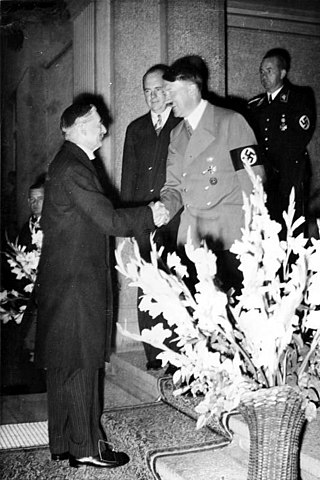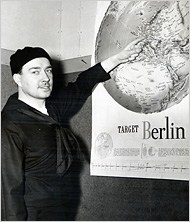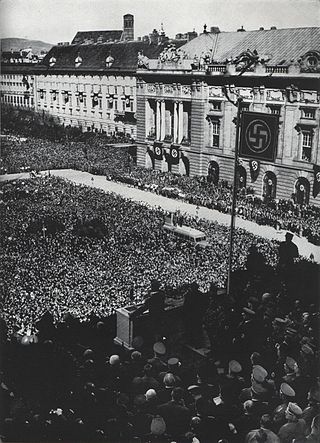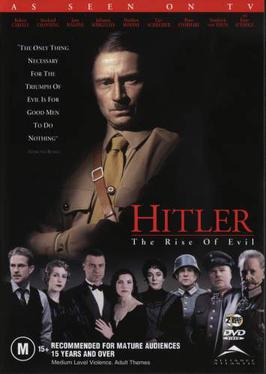
Hermann Wilhelm Göring was a German politician, military leader and convicted war criminal. He was one of the most powerful figures in the Nazi Party, which ruled Germany from 1933 to 1945.

Mein Kampf is a 1925 autobiographical manifesto by Nazi Party leader Adolf Hitler. The work describes the process by which Hitler became antisemitic and outlines his political ideology and future plans for Germany. Volume 1 of Mein Kampf was published in 1925 and Volume 2 in 1926. The book was edited first by Emil Maurice, then by Hitler's deputy Rudolf Hess.

The Beer Hall Putsch, also known as the Munich Putsch, was a failed coup d'état by Nazi Party leader Adolf Hitler, Generalquartiermeister Erich Ludendorff and other Kampfbund leaders in Munich, Bavaria, on 8–9 November 1923, during the Weimar Republic. Approximately two thousand Nazis marched on the Feldherrnhalle, in the city centre, but were confronted by a police cordon, which resulted in the deaths of 16 Nazi Party members and four police officers.

Appeasement, in an international context, is a diplomatic policy of making political, material, or territorial concessions to an aggressive power to avoid conflict. The term is most often applied to the foreign policy of the British governments of Prime Ministers Ramsay MacDonald, Stanley Baldwin and Neville Chamberlain towards Nazi Germany and Fascist Italy between 1935 and 1939. Under British pressure, appeasement of Nazism and Fascism also played a role in French foreign policy of the period but was always much less popular there than in the United Kingdom.

William Patrick Stuart-Houston was an English-born half-nephew of Adolf Hitler. Born and raised in the Toxteth area of Liverpool to Adolf's half-brother Alois Hitler Jr. and his Irish wife Bridget Dowling, he later relocated to Germany to work for his half-uncle before emigrating to the United States, where he received American citizenship and ended up serving in the United States Navy against his half-uncle during World War II.

Ernst Franz Sedgwick Hanfstaengl was a German-American businessman and close friend of Adolf Hitler. He eventually fell out of favour with Hitler and defected from Nazi Germany to the United States. He later worked for Franklin D. Roosevelt and was once engaged to the author Djuna Barnes.

Adolf Hitler was an Austrian-born German politician who was the dictator of Germany from 1933 until his suicide in 1945. He rose to power as the leader of the Nazi Party, becoming the chancellor in 1933 and then taking the title of Führer und Reichskanzler in 1934. During his dictatorship, he initiated World War II in Europe by invading Poland on 1 September 1939. He was closely involved in military operations throughout the war and was central to the perpetration of the Holocaust: the genocide of about six million Jews and millions of other victims.

Ewald-Heinrich Hermann Konrad Oskar Ulrich Wolf Alfred von Kleist-Schmenzin was a German publisher and convenor of the Munich Conference on Security Policy until 1998. A member of the von Kleist family and an officer in the Wehrmacht during World War II, his parents were active in the German resistance against Adolf Hitler. Von Kleist was designated to kill Hitler in a suicide attack and was the last surviving member of the 20 July 1944 plot to assassinate Hitler.

Adolf Hitler's rise to power began in the newly established Weimar Republic in September 1919 when Hitler joined the Deutsche Arbeiterpartei. He rose to a place of prominence in the early years of the party. Being one of its best speakers, he was made the party leader after he threatened to otherwise leave.

The Führermuseum or Fuhrer-Museum, also referred to as the Linz art gallery, was an unrealized art museum within a cultural complex planned by Adolf Hitler for his hometown, the Austrian city of Linz, near his birthplace of Braunau. Its purpose was to display a selection of the art bought, confiscated or stolen by the Nazis from throughout Europe during World War II. The cultural district was to be part of an overall plan to recreate Linz, turning it into a cultural capital of Nazi Germany and one of the greatest art centers of Europe, overshadowing Vienna, for which Hitler had a personal distaste. He wanted to make the city more beautiful than Budapest, so it would be the most beautiful on the Danube River, as well as an industrial powerhouse and a hub of trade; the museum was planned to be one of the greatest in Europe.

Eduard Bloch was an Austrian physician practicing in Linz, who, for many years until 1907, was the family doctor of Adolf Hitler and his family. When Hitler's mother, Klara, was dying of breast cancer, Bloch billed the family at a reduced cost and sometimes refused to bill them outright. When the Nazis annexed Austria in 1938, Hitler awarded Bloch special protection and personally intervened to ensure his safety, as Bloch was an Austrian Jew. Following Kristallnacht and the escalation of anti-Jewish sentiment in Germany, Hitler allowed Bloch to emigrate to the United States, where he lived until his death in 1945, succumbing to stomach cancer.

The Anschluss, also known as the Anschluß Österreichs, was the annexation of the Federal State of Austria into the German Reich on 13 March 1938.

Paul-Otto Schmidt was an interpreter in the German foreign ministry from 1923 to 1945. During his career, he served as the translator for Neville Chamberlain's negotiations with Adolf Hitler over the Munich Agreement, the British Declaration of War and the surrender of France.

The men's dormitory on Meldemannstraße 27 in Brigittenau district, Vienna, Austria was a public dormitory for men (Männerwohnheim) from 1905 to 2003. It is a subject of public interest primarily because it was the residence of Adolf Hitler, the later dictator of Nazi Germany, from 1910 to 1913.

Reinhold Hanisch was an Austrian migrant worker and sometime business partner of the young Adolf Hitler. Hanisch, who published articles on Hitler, with whom he had lived in 1910, is, next to August Kubizek, one of the few witnesses to Hitler's Vienna years.

Hitler: The Rise of Evil is a Canadian television miniseries in two parts, directed by Christian Duguay and produced by Alliance Atlantis. It stars Robert Carlyle in the lead role and explores Adolf Hitler's rise and his early consolidation of power during the years after the First World War and focuses on how the embittered, politically fragmented and economically buffeted state of German society following the war made that ascent possible. The film also focuses on Ernst Hanfstaengl's influence on Hitler's rise to power. The miniseries, which premiered simultaneously in May 2003 on CBC in Canada and CBS in the United States, received two Emmy Awards, for Art Direction and Sound Editing, while Peter O'Toole was nominated for Best Supporting Actor.

Adolf Hitler, dictator of Germany from 1933 to 1945, was also a painter. He produced hundreds of works and sold his paintings and postcards to try to earn a living during his Vienna years (1908–1913). Despite little success professionally, he continued to paint throughout his life.

Franz Josef Huber was an SS functionary who was a police and security service official in both the Weimar Republic and Nazi Germany. Huber joined the Nazi Party in 1937 and worked closely with Gestapo chief Heinrich Müller. After the German annexation of Austria in 1938, Huber was posted to Vienna, where he was appointed chief of the Security Police (SiPo) and Gestapo for Vienna, the "Lower Danube" and "Upper Danube" regions. He was responsible for mass deportations of Jews from the area. After the war ended, Huber never served any prison time. He was employed by the West German Federal Intelligence Service from 1955–64. He died in Munich in 1975.

Adolf Hitler's Munich apartment was an apartment owned by Adolf Hitler, located at Prinzregentenplatz 16 in the German city of Munich, the birthplace and capital of the Nazi Party which was formed in Munich in 1920.
Adolf Hitler, dictator of Germany from 1933 to 1945, earned millions of Reichsmarks (ℛℳ) throughout his political career, mainly through sales of his book Mein Kampf and his combined Chancellor's and President's salaries. After coming to power, Hitler made himself tax-exempt.



















